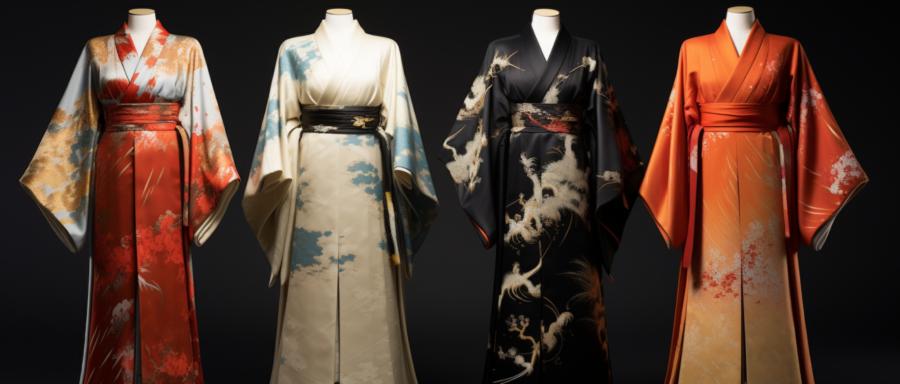Samurai and Kimonos: Fashion Statements of Feudal Japan

Samurai: The Warriors of Impeccable Style
When it comes to fashion, the Samurai of feudal Japan were like the spiritual predecessors of Elton John, only with less glitter and more fatal swordplay. These noble warriors dressed to impress with their flamboyant armor, known as "yoroi," which was not only designed to protect them in battle but also to make a statement about their social status, their wealth, and their exquisite taste in color palettes.Samurai armor was constructed from a variety of materials, including leather, metal, and silk. The Japanese didn't mess around when it came to their protective gear, often adorning it with delicately crafted and intricate designs, as well as some downright terrifying masks. Each suit of armor was meticulously produced by skilled artisans who were basically the Coco Chanel of their time.
Samurai Armor: The Ultimate Accessory
Samurai didn't just wear their armor for protection, oh no, it was also a fantastic conversation starter at parties. "Oh, this old thing? I got it from a renowned armorer in Kyoto. It's made from the finest steel and lacquered leather. Did I mention it's bulletproof?"But seriously, Samurai armor wasn't just about keeping the wearer safe from pointy objects (though that was a crucial aspect); it also served as a symbol of power, a way to intimidate enemies, and of course, a vessel to showcase their impeccable fashion sense. One could say that the Samurai were the original celebrities of the red carpet, except instead of posing for cameras, they were posing for battle.
When it came to Samurai fashion, the helmet, or "kabuto," was the pièce de résistance. This essential piece of headgear could be adorned with intricate designs, crests, and even antlers or horns, because who doesn't want to look like a majestic deer while slicing through enemies on the battlefield?
Roll Out the Kimono: A Staple in the Japanese Wardrobe
While the Samurai were strutting their stuff in their elaborate armor, the rest of Japan was rocking the kimono, a traditional garment that is still worn today. Though not as flashy or intimidating as Samurai armor, the kimono was (and still is) an essential piece in the Japanese wardrobe, signifying elegance, grace, and a dash of intrigue.Originally worn by men and women alike, kimonos are created from a single bolt of fabric, wrapped around the body in a particular way, and secured with a sash known as an "obi." Now, if you're thinking that this sounds like a glorified bathrobe, think again. Kimonos were (and still are) made from a variety of luxurious materials like silk, hand-painted or embroidered with intricate patterns, ensuring that the wearer was looking fabulous at all times. I'm talking Beyoncé-level fabulous, people.
Kimonos: Formal Wear for the Discerning Japanese Citizen
Just like we have different outfits for different occasions, kimonos also came in various styles, lengths, and patterns to suit the situation. There were casual kimonos for everyday wear, semi-formal kimonos for tea ceremonies, and formal kimonos for weddings or other special events. It was like the little black dress of feudal Japan, except with way more fabric and nowhere to hide a flask of sake.As the social status of the wearer was important, the choice of kimono was crucial. The higher the status, the more elaborate the kimono, with the Emperor himself donning a 12-layer kimono made from the finest silk. Just imagine the dry cleaning bill!
Mastering the Art of Kimono Wearing
While it might seem easy to wrap yourself in a giant piece of fabric and call it a day, wearing a kimono is, in fact, an art form. There is a specific order and technique to wrapping, folding, and securing the kimono to ensure that the wearer looks flawless and doesn't accidentally unravel in public like a mummy with a wardrobe malfunction.- First, the undergarments are put on, followed by the "nagajuban," a sort of under-kimono that provides a layer between the wearer and the actual kimono.
- Next, the kimono is wrapped around the body, left side over the right. This is important, as the opposite way (right over left) is reserved for the deceased at funerals. Talk about a fashion faux pas!
- Finally, the obi is wrapped around the waist and tied in a particular knot, depending on the occasion or personal preference. This knot can be a simple bow or an elaborate, multi-layered creation that rivals the complexity of a Rubik's Cube.
Article kindly provided by foreverinfashion.org
Latest Articles
- The Psychology of Tattoo Aesthetics: Why Certain Imagery Resonates
- Style That Works With Your Body, Not Against It
- Fashion Tourism on Wheels: Curated Shopping Routes Led by Chauffeur Guides
- The Charm of Certainty in a World of Indecision
- Can an Everyday T-Shirt Be Turned into a Modern Heirloom?
- Color, Ceremony, and the Psychology of Celebration
- Styling Graphic T-Shirts for Different Body Types
- Getting Kids to Wear Their Hats Without a Bribe or a Meltdown
- Mastering the Art of Being the Unnoticed Photographer
- Quiet Sportswear Moves Loudly
- Fashion's Most Misunderstood Color Is Brown
- Weight Matters When Cotton Gets Real
- SKU's Out for Summer: Why Your Warehouse Is Melting Down
- Ink as Accessory - How Tattoos Are Replacing Jewelry in Modern Style
- Accessories
- Jewellery
- Footwear
- Skirts and Dresses
- Shirts and Blouses
- Beauty and Makeup
- Fashion Photography
- Sustainable Fashion
- Street Style
- Fashion History
- Fashion Business
- Fashion Styling
- Fashion Events
- Plus-Size Fashion
- Men's Fashion
- Women's Fashion
- Fashion Blogging
- Fashion Trends
- Fashion Retailers
- Fashion Tips and Advice
- Fashion Business Startups
- Fashion Around the World
- Lingerie
- Sportswear
- Weddings

